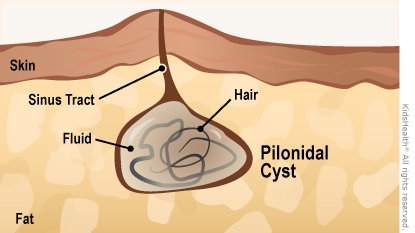Pilonidal Cyst
What Is a Pilonidal Cyst?
A pilonidal cyst is a fluid-filled sac under the skin in the lower back, near the crease of the buttocks. Some aren't visible, while others can look like a small pit or dimple in the skin.
They don't usually cause problems or need treatment unless they get infected. A pilonidal (pie-luh-NIE-dul) cyst that's infected is called a pilonidal abscess.
-

30-Second Summary: Pilonidal Cyst
Learn the basics in 30 seconds.
What Are the Signs & Symptoms of a Pilonidal Cyst?
A cyst that isn't infected might not cause any symptoms. Someone with an infected cyst can have:
- pain, redness, and swelling in the area of the cyst
- pus or blood draining from a small opening (called a sinus tract) in the skin over or near the cyst
- a fever
What Causes a Pilonidal Cyst?
Doctors think that pilonidal cysts form when loose hair and dead skin cells get trapped under the skin. When we sit or bend, skin in the tailbone area stretches. This can cause hairs to break off. As a person moves, the broken hairs and dead skin cells can get pushed under the skin. The immune system treats the hair and dead skin cells as foreign, and forms a cyst around them that fills with fluid.

Anyone can get a pilonidal cyst, but they're most common in young men.
A pilonidal cyst can be more likely if someone:
- is born with a dimple or pit in their tailbone area
- spends a lot of time in a sitting position
- is overweight
- has a lot of body hair, especially if it's thick or coarse
- wears tight clothing that presses on the tailbone area
- has family members with a pilonidal cyst
How Is a Pilonidal Cyst Diagnosed?
Doctors usually diagnose a pilonidal cyst based on where it is and how it looks and feels.
How Is a Pilonidal Cyst Treated?
A cyst that doesn't cause symptoms might not need treatment. A doctor might recommend removing hair from the area with a laser (laser epilation) or other methods.
Treatment for a pilonidal abscess depends on how severe the infection is. Home care with sitz baths and warm compresses can treat mild infections. If home care doesn't work or the infection is more serious, doctors might make a small cut to drain the abscess. They might prescribe antibiotics if the infection spreads to skin around the cyst.
After an infection has healed, a doctor might do surgery to treat the condition and prevent further problems. In one type of surgery — the Gips procedure — the doctor uses a small surgical tool to remove the sinus tract, and then cleans out the hair and debris from inside the cyst.
How Can Parents Help?
To care for a pilonidal cyst at home:
- Clean the area as directed.
- If the doctor tells you to, regularly remove hair from the area by using a hair removal product.
- Remind your child to avoid sitting for long periods of time.
- Suggest that your child sleep on their side or stomach, which can be more comfortable.
If your child had a pilonidal cyst drained:
- If the doctor prescribed antibiotics, give them as directed.
- Change or remove the bandage as recommended.
- Your child shouldn't take a bath or swim until the doctor says it's OK.
What Else Should I Know?
Even after surgery, pilonidal cysts sometimes come back. Keeping the area clean and free of hair can help prevent an infection and new cysts.
